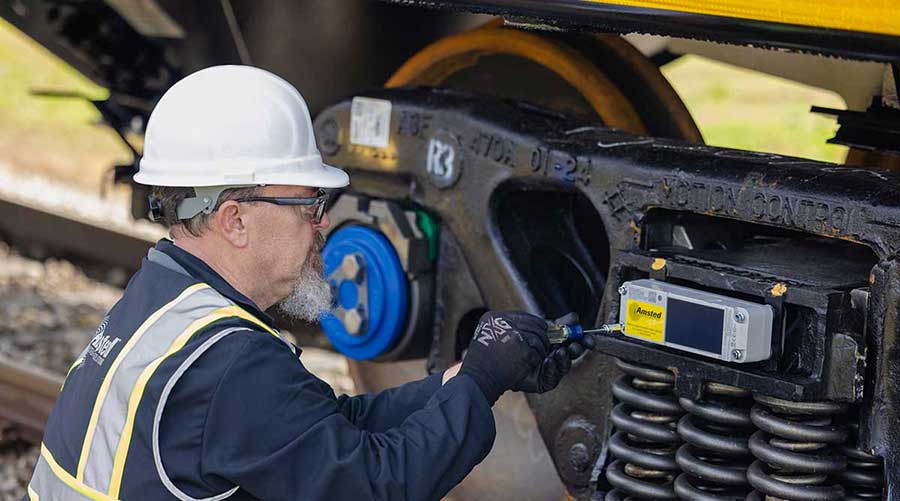Stay updated on news, articles and information for the rail industry
May 2020
Rail News: Rail Industry Trends
Oil Storage: Rail to the rescue? Not likely

Oil, is it? Black gold? Texas tea? I don’t think Jed’s a millionaire anymore … unless he took his money from Mr. Drysdale’s bank and invested in Cushing cash or super-tanker treasure — but not rail car reward.
Crude by rail (CBR)/storage: Waiting for Godot? The San Pedro basin (L.A./Long Beach) apparently looks like it did in the ILWU strike of 2002 — ships lined up for miles (also like photos of D-Day +1). So much has been written recently on the oil storage (price/production) issue with empty rail tank cars as a possible (at least partial) solution:
• Financial Times: “Oil Traders Turn to Salt Caves and Railcars in Storage Crisis,” although the subtitle noted that they missed their deadline: “Peak Pressure Might be Over”)
• Bloomberg/BusinessWeek: “No Room in the Tank”
• Wall Street Journal's Heard on the Street: “Oil’s Crash Prompts Push to Store Fuel at Sea”
Gold or fools’ gold? So, while others have speculated on putting those parked tank cars to use, creating a possible silver lining to this black-plague-filled period, our discussions with top stakeholders — the leasing companies that own the rolling stock; the OEMs; the railroads large and small that move oil (CBR), or not, as the case is now, and could, maybe, store oil; energy companies; storage businesses; and analysts (thanks, particularly, to Mark Bononi, oil expert par excellence, and rail-car expert Dick Kloster) — and we have come to the conclusion, always risky in these fluid times, that rail is certainly not the solution to the oil storage “crisis.” In fact, it isn’t likely to be of niche support. Why? The usual suspects: Money, risk, timing.
First, some factoids to frame the situation: We know about the Saudis and the Russians, the demand destruction, the cotango, super-contango and negative pricing, since it's recovered a bit. The International Energy Agency puts global energy demand at -6 percent (and the United States at -9 percent) with “downside risk.” Note: Emissions are estimated to be down 8 percent. Oil has become price inelastic these days. In addition:
• U.S. shale bankruptcies were up 50 percent in 2019 (the sector had already fell out of investor favor before this crisis).
• Energy independent? U.S. production ended 2019 at ~15mmbd, two times the level of 2008 (coal’s peak, by the way) — and could drop to ~ 10mmbd by September. Put in perspective, the world produces ~ 100mmbd and consumes about that amount — in normal times.
• U.S. shale capex (that’s steel in rail cars, etc.) is down by 30 percent to 40 percent.
• U.S. rigs down ~40 percent.
• Speaking of missing rail movements, do not forget the collapse of the ethanol market — which may ... may ... lead to more export/rail share corn if ... if .... China buys.
• Shell cut its dividend for the first time since 1945 — by two-thirds (and it’s not just a temporary fix: It’s a “re-set”); it cut capex by 20 percent. BP is reviewing its dividend. ExxonMobil and Chevron have cut capex by 30 percent (it was Chevron's second cut in two weeks). Meanwhile, ExxonMobil’s stock price is essentially unchanged after 20 years.
• Super-tanker (VLCC) rates have exploded, though they have halved in the span of a week (one consultant said costs were ~$15-18K/day, so still at $75K/day, an almost CP-like return.
• Oil “stored” in tankers has gone from ~34mmbl in March to 158mm as of April 24.
• U.S. storage capacity is 652mmbl (370 U.S. Gulf, ~198 in Cushing, Oklahoma, ~85mm “elsewhere”). It is ~75 percent full, but the rest is “spoken for."
So why not rail cars?
Clearly, some car owners and some (short-line) railroads have explored this — and as the Financial Times noted, car storage in Chicago — but that seem implausible. But let’s break this down into a few categories:
1. Risk (this is hazmat storage)
• The Class Is (which could provide transportation, switching and storage) want no part of this, from what I can tell — the liabilities outweigh the rewards. Short lines are nimbler, some may have interest, but storage space is at a premium already. And Class I reluctance is a major barrier in the network they control.
• Lease duration is also a risk element — is this bubble already over? Will counterparties accept take or pay provisions and multi-year leases?
• Much of the oil market is controlled by speculators — many leasing companies would not want to take counter-party risk with such entities?
2. Space is at a premium already, as noted, given the ~25 percent drop in volumes (against what we had thought were “easy” comparisons!)
• New space costs ~$1-2mm/mile.
• Although rails have built storage in transit (SIT) yards for plastics shippers, storage hardly fits the PSR philosophy.
• A rail-car holds ~700/bl of oil; there are 30K-50K available (all-in) “new” (117) tank cars — if every car was so utilized, that would be 35mmb.
• One VLCC can hold 2mmb — that’s equal to 30-32 100-car train-sets, and 34 miles of track!
• The storage would likely be all over the North American rail network.
3. Costs — where the steel meets the rail
• Scrapping still, even today, nets ~$5k/car — no muss, no fuss.
• Hazmat regulations apply (which costs money and time) — could this be changed in an “emergency”
• Corrosion is a factor — although I have been repeatedly told that most cars are stored clean and mostly ready to go, for CBR/S, a corrosion coating costing ~$8-12K/car would be necessary.
• Hazmat storage rates top ~$10/day (non hazmat is ~$3-7) — but even at $15, meaning $50K/month per 100-car set, versus the liability risk.
•·Daily storage rates may be only ~$1/bl — that seems reasonable, on the face of it, but it excludes transportation and assembly, transloading, etc.
•·Add in the switching costs ($350/car for hazmat, $200 for non).
• Plus the costs of assembling the fleets from around the North American network.
4. Time, the ruler of us all...
• So I think I get the idea here: If the time were to be extended … maybe the leasing companies could help change the real deal-breaker — 1B! Most observers see this as a short-term opportunity, which is hard for rails and leasing companies owning long-lived assets scattered across the continent. But not all see it that way. Will the June WTI futures cause a repeat of the May debacle? Watch here.
• One idea I and others have had is take the all outdated (or soon to be) 111 and 1232 cars, and move them empty to, say Cushing, Oklahoma; create permanent (and cheaper) purely storage tracks (think: mobile home parks), removing them from transport regs, from C1 cares and connect them to the big tanks there. Most that I have asked were praising the innovative mindset of the questioner, but also skeptical of the ability to move them to one place quickly enough to take advantage of what could be — by rail standards — a short-er term opportunity (versus that $5K scrap fee in hand).
Email comments or questions to abh18@mindspring.com.


 LRW Honors Amtrak’s Acheson As Railway Woman Of The Year
LRW Honors Amtrak’s Acheson As Railway Woman Of The Year
 From Editor-In-Chief Foran: Of Gender Equity And Inclusion
From Editor-In-Chief Foran: Of Gender Equity And Inclusion
 Spotlight On Some Of Today’s Rail Safety Products
Spotlight On Some Of Today’s Rail Safety Products
 Women of Influence in Rail eBook
Women of Influence in Rail eBook
 railPrime
railPrime







